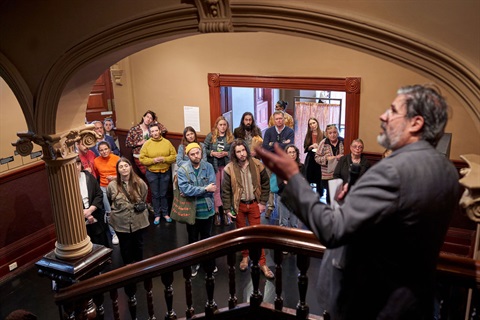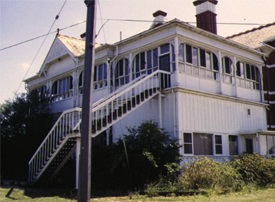About the building

Discover more about the history of our building.
The building
In 1899, John Matthew Vincent Smith, a leader in the horse breeding and racing industry, acquired the property known as "Bundoora Park".
The house was in "Bundoora" after the Aboriginal word. Meaning the favourite place of the kangaroo.
The homestead had 606 acres (245 hectares) of land, and is part of the territory of the Wurundjeri-william clan.

The architect
In that same year, Smith organised a public architectural competition for the design of a new homestead.
First prize of $50 pounds winning by Sydney Herbert Wilson for a double-storey asymmetrical plan.
A red brick mansion with dominant hipped roofs, protruding strapped gables, and tall brick and stucco chimneys.
Wilson, a leading Melbourne architect, who also designed the Malvern Town Hall, lead the project.
Bundoora Homestead is one of the best remaining of Sydney Wilson's works. A strong example of the English Queen Anne Style as adapted to the Australian environment.
The homestead and estate
In 1900, by J.B. Sewell & Co builders, "Bundoora" was a 14 room mansion.
It had:
- a grand entrance hall, a central stair hall, a drawing room (converted to a billiard room by 1910)
- a parlour, a dining room, a morning room, a butler’s pantry, a server, a servant’s hall, a kitchen, scullery and larders, a laundry, and a household water closet.
- upstairs there were eight bedrooms with the principal bedroom having an ensuite bathroom and dressing room.
- two more bathrooms and a linen room.
You could see from the balconies, the City of Melbourne in the distance. With sweeping vistas from the Dandenong Ranges to the south-east across to Mount Macedon to the north-west.
The grounds and gardens
James Upham, a former curator of the Bendigo Botanical Gardens, created the grounds.
An ornamental garden encircled the mansion with plantings of rhododendron, azalea, and beds of roses.
An orchard, extensive vegetable gardens.
A large conservatory filled with profuse ferns and exotic flowering plants existed.
The lavish gardens stretched to Plenty Road. They had 3 full-time gardens to maintain it.
JMV Smith and his family lived at Bundoora Park for about 20 years and it was a horse and cattle stud.
The horse – Wallace
Wallace, son of the 1890 Melbourne Cup winner, Carbine, became Bundoora Park’s best-known resident.
A majestic galloper, Wallace won the Caulfield Guineas, Victoria Derby, and Sydney Cup by the time he was three years old.
It was his 22 years at stud that he was well known for.
Wallace's offspring competed in 949 races, winning $246,000 pounds in prize money.
Wallace died in 1917, aged 25 buried close to the Bundoora Park stables. His grave marked by a flat stone cairn inscribed with his name.
Legend claims that a ghost horse is watching over, near Wallace's grave. At night if you hear the clip-clop of hooves, it is his stablemate, a mare called Lurline, coming to see who goes near him.

Bundoora Convalescent Farm
In December 1920, JVM Smith sold Bundoora Park to the Commonwealth Government for $28,000 pounds.
Bought to create a place for the rehabilitation of WW1 veterans suffering mental disorders as a result of their military service.
It was the first psychiatric facility established in Victoria to meet the specific needs of returned servicemen.
Chosen because of its isolated location. At the time, mental treatment and rehabilitation were doing farming activities. On the opposite side of Plenty road was the Mont Park Psychiatric Hospital.
It housed approximately 30 patients. As well as nursing and domestic staff and, by 1922, the same year that John Matthew Vincent Smith died, accommodated some 60 patients.
Mental Repatriation Hospital
Renamed in 1923 the Convalescent Farm became the Mental Repatriation Hospital. In May 1924 control of the facility changed to the Victorian State Government.
Victoria Police Stud
In 1930, 456 acres (184.5 hectares) of the property, including the original thoroughbred stables, stud master’s brick cottage, and a small timber hut (used as accommodation for Aboriginal trackers)was allocated for use by the Victoria Mounted Police. The Victoria Police stud and stables operated from Bundoora Park until 1952.
The Victoria Police stud and stables operated from Bundoora Park until 1952.
Mental Repatriation Hospital, Dr. John Cade and his discovery
Australian psychiatrist, Dr. John Cade’s discovered the effective use of lithium carbonate in mental illness treatment.
Estimated to have saved the world at least $17.5 billion in medical costs over a 15 year period between 1970-1985 (the American National Institute of Mental Health).
Dr. Cade’s discovery in psychiatric circles worldwide was acclaimed.
A Prisoner Of War (POW) for three and a half years in Changi, Dr. Cade resumed his medical career upon returning to Australia in 1945.
In 1946, at the age of thirty-four, he was appointed Psychiatry Superintendent at Bundoora (Mental) Repatriation Hospital in Victoria.
He believed that some mental illnesses had an underlying metabolic disturbance, that could lead to rational and effective treatment
He investigated his theory in the disused old ward kitchen that served as his research laboratory.
Dr. Cade soon found that the urine of manic patients was more toxic than normal urine. With his next discovery, by trial and error, that a lithium extract had a marked protective effect against this toxicity.
He knew he was on the verge of a major breakthrough.
In 1948, after testing it on himself, he experimented with the extract in the treatment of a disturbed patient who had been for five years in a high dependency ward at Bundoora.
Within a week, the patient became calm and was transferred to an open rehabilitation ward where his improved condition remained stable. A month after treatment began, the patient was able to return home to his family and former job.
A further 9 patients responded in a similar manner to the experimental treatment. Dr. Cade published his findings in "the Medical Journal of Australia" in September 1949.
Bundoora Repatriation Hospital
The hospital continued to expand its facilities and services.
In 1965, the sprawling campus on the slopes of Mount Cooper was renamed the Repatriation Hospital, Bundoora.
The hospital campus grew to eight wards with a maximum of 291 beds and employed almost 200 staff including 90 nursing and 75 artisan staff.
At the same time, the Homestead (by then known as Ward 2) renovated was renovated and adapted as a Day Hospital caring for up to 40 patients per day.
An official report from 1968 states:
“The aim of the hospital is complete rehabilitation and return to the community for all patients capable of this progression and for the others, psychiatric and medical care and an active therapeutic programme.”
Some recreation and leisure pursuits including: sporting days on the cricket oval, golf course and tennis court, two small swimming pools, a bowling green, a putting green and volleyball facility.
Indoor activities consisted of card games, billiards; three picture shows a week and two dances per month!
About repatriation patients, the report concluded:
“Admissions and discharges are fairly constant at approximately 200 in both categories each year. Deaths average between 30 and 40 for each twelve months and are mainly World War 1 veterans.”
In 1993, the hospital closed and the ownership was transferred from Commonwealth to the State government.
By December 1996, most of the buildings were demolished. The former JMV Smith mansion standing alone and unoccupied.
The Preston Historical Society created a historical museum. Using the former Bundoora Park stables, stud master’s cottage and blacksmith’s shop and shed buildings.
Bundoora Homestead Art Centre
Helped by La Trobe University and the Commonwealth Government Federation fund the house was restored by our Council. Opening, September 2001 to the community as a heritage and cultural space.
Bundoora Homestead is registered by Heritage Victoria and certified by the National Trust.
Image: Opening event at Bundoora Homestead Art Centre. Photo by Tiny Empire